Business Law Assignment: Impact on Organizations - UKCBC, Unit 7
VerifiedAdded on 2023/06/13
|22
|5739
|452
Report
AI Summary
This business law assignment comprehensively analyzes the UK legal system, focusing on its impact on business organizations. It examines Hart's three-part legal system within the UK context, including the roles of statutory law, common law, and customs. The assignment details the legislative process, from bill formulation to enactment, and explores key legislations such as the Partnership Act, Companies Act, and Equality Act. It further investigates employer obligations concerning occupational health and safety, workers' compensation, harassment, and equal opportunities, referencing relevant acts like the Health and Safety at Work Act 1974 and the Equality Act 2010. The paper also addresses legal solutions to business problems, including contract law and intellectual property rights, and recommends appropriate legal strategies based on alternative legal advice. This document, contributed by a student, is available on Desklib, which provides a range of study tools for students.
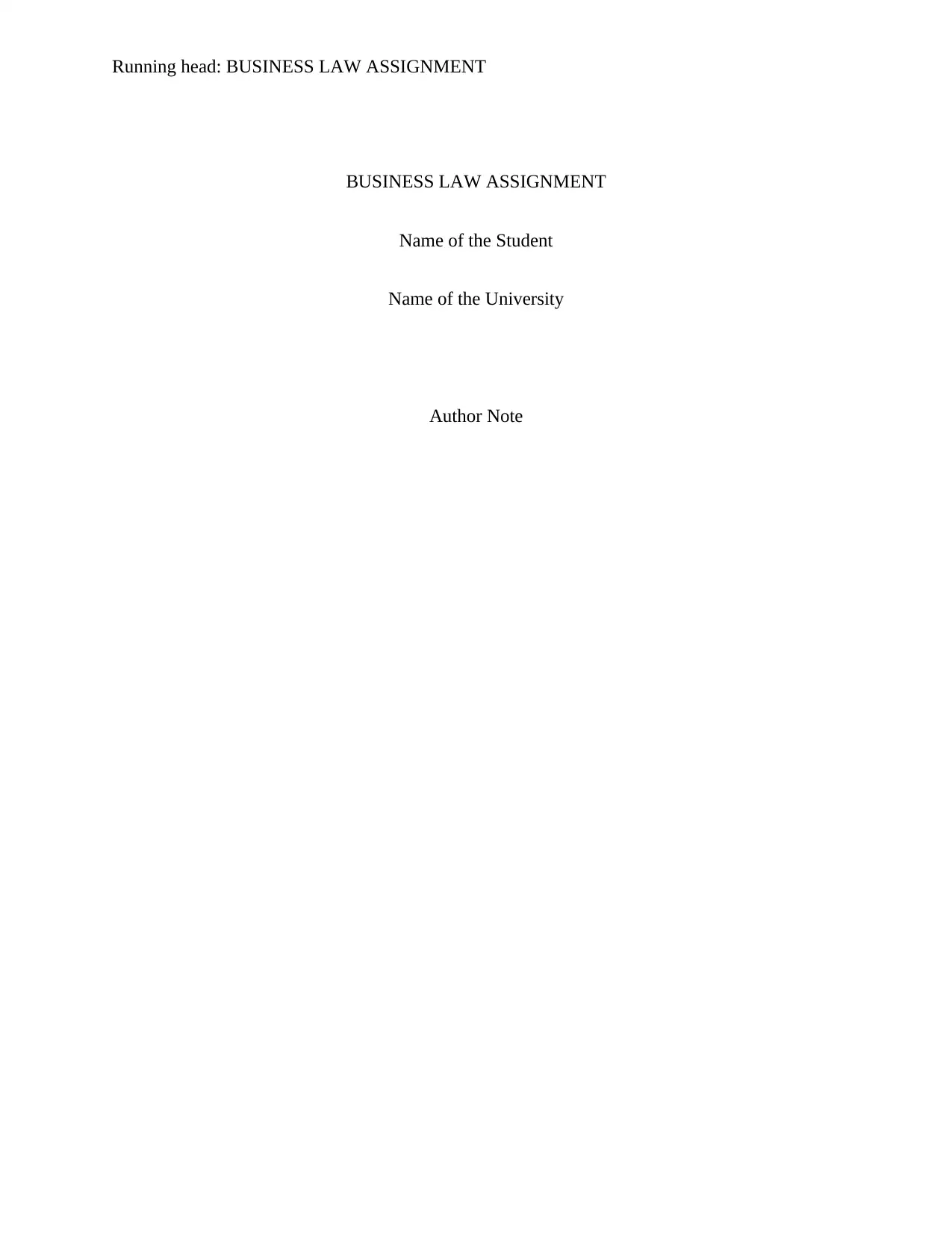
Running head: BUSINESS LAW ASSIGNMENT
BUSINESS LAW ASSIGNMENT
Name of the Student
Name of the University
Author Note
BUSINESS LAW ASSIGNMENT
Name of the Student
Name of the University
Author Note
Paraphrase This Document
Need a fresh take? Get an instant paraphrase of this document with our AI Paraphraser
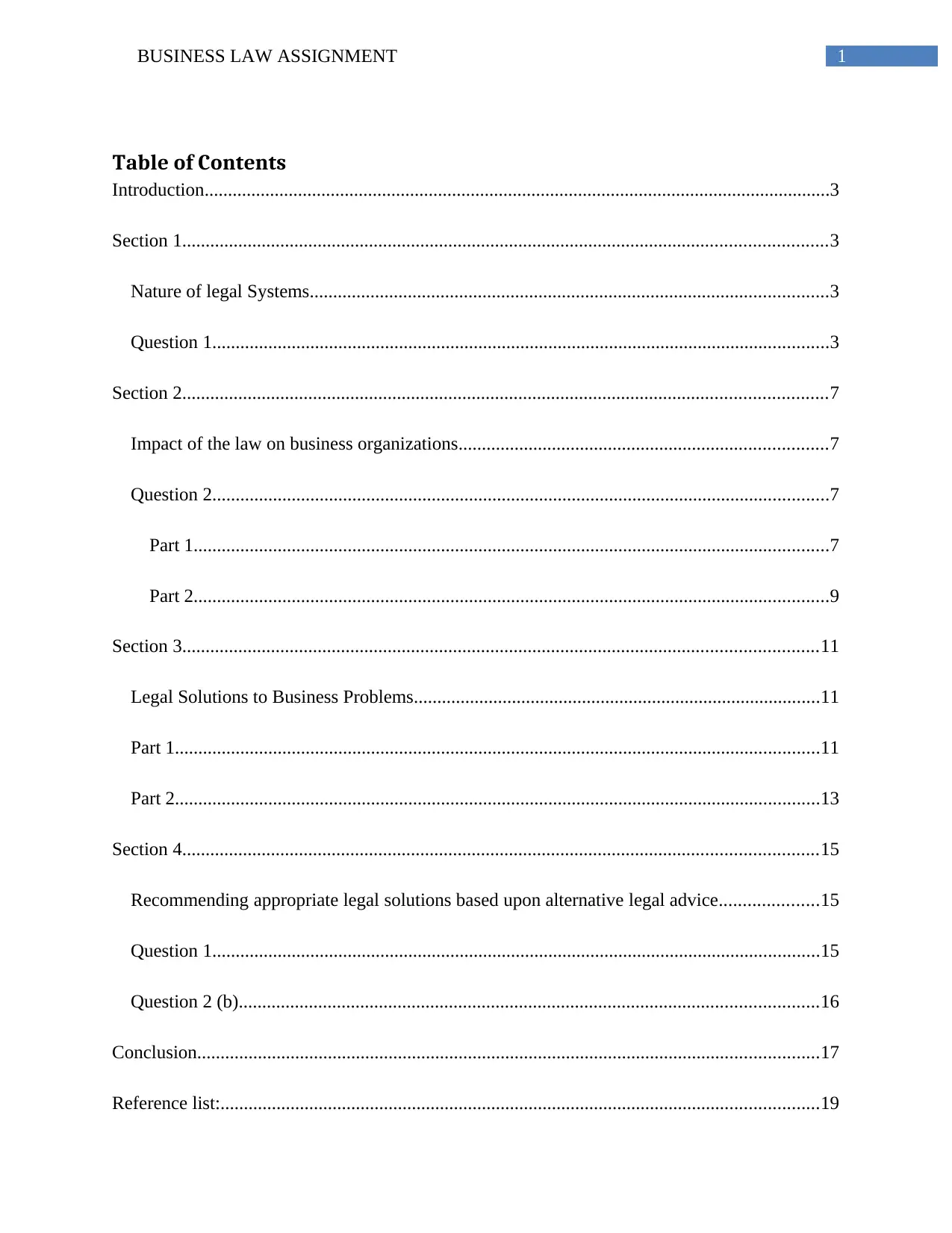
1BUSINESS LAW ASSIGNMENT
Table of Contents
Introduction......................................................................................................................................3
Section 1..........................................................................................................................................3
Nature of legal Systems...............................................................................................................3
Question 1....................................................................................................................................3
Section 2..........................................................................................................................................7
Impact of the law on business organizations...............................................................................7
Question 2....................................................................................................................................7
Part 1........................................................................................................................................7
Part 2........................................................................................................................................9
Section 3........................................................................................................................................11
Legal Solutions to Business Problems.......................................................................................11
Part 1..........................................................................................................................................11
Part 2..........................................................................................................................................13
Section 4........................................................................................................................................15
Recommending appropriate legal solutions based upon alternative legal advice.....................15
Question 1..................................................................................................................................15
Question 2 (b)............................................................................................................................16
Conclusion.....................................................................................................................................17
Reference list:................................................................................................................................19
Table of Contents
Introduction......................................................................................................................................3
Section 1..........................................................................................................................................3
Nature of legal Systems...............................................................................................................3
Question 1....................................................................................................................................3
Section 2..........................................................................................................................................7
Impact of the law on business organizations...............................................................................7
Question 2....................................................................................................................................7
Part 1........................................................................................................................................7
Part 2........................................................................................................................................9
Section 3........................................................................................................................................11
Legal Solutions to Business Problems.......................................................................................11
Part 1..........................................................................................................................................11
Part 2..........................................................................................................................................13
Section 4........................................................................................................................................15
Recommending appropriate legal solutions based upon alternative legal advice.....................15
Question 1..................................................................................................................................15
Question 2 (b)............................................................................................................................16
Conclusion.....................................................................................................................................17
Reference list:................................................................................................................................19
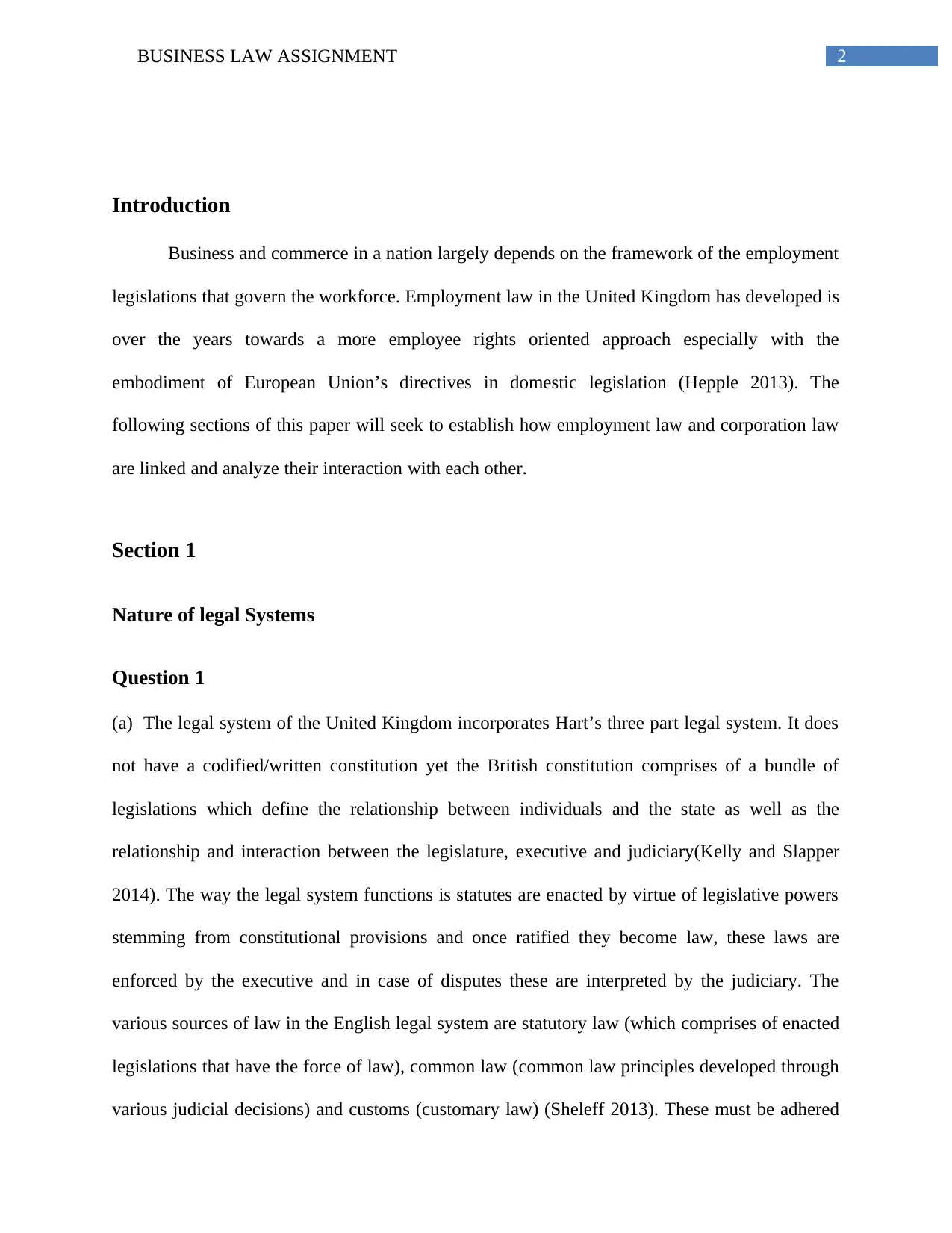
2BUSINESS LAW ASSIGNMENT
Introduction
Business and commerce in a nation largely depends on the framework of the employment
legislations that govern the workforce. Employment law in the United Kingdom has developed is
over the years towards a more employee rights oriented approach especially with the
embodiment of European Union’s directives in domestic legislation (Hepple 2013). The
following sections of this paper will seek to establish how employment law and corporation law
are linked and analyze their interaction with each other.
Section 1
Nature of legal Systems
Question 1
(a) The legal system of the United Kingdom incorporates Hart’s three part legal system. It does
not have a codified/written constitution yet the British constitution comprises of a bundle of
legislations which define the relationship between individuals and the state as well as the
relationship and interaction between the legislature, executive and judiciary(Kelly and Slapper
2014). The way the legal system functions is statutes are enacted by virtue of legislative powers
stemming from constitutional provisions and once ratified they become law, these laws are
enforced by the executive and in case of disputes these are interpreted by the judiciary. The
various sources of law in the English legal system are statutory law (which comprises of enacted
legislations that have the force of law), common law (common law principles developed through
various judicial decisions) and customs (customary law) (Sheleff 2013). These must be adhered
Introduction
Business and commerce in a nation largely depends on the framework of the employment
legislations that govern the workforce. Employment law in the United Kingdom has developed is
over the years towards a more employee rights oriented approach especially with the
embodiment of European Union’s directives in domestic legislation (Hepple 2013). The
following sections of this paper will seek to establish how employment law and corporation law
are linked and analyze their interaction with each other.
Section 1
Nature of legal Systems
Question 1
(a) The legal system of the United Kingdom incorporates Hart’s three part legal system. It does
not have a codified/written constitution yet the British constitution comprises of a bundle of
legislations which define the relationship between individuals and the state as well as the
relationship and interaction between the legislature, executive and judiciary(Kelly and Slapper
2014). The way the legal system functions is statutes are enacted by virtue of legislative powers
stemming from constitutional provisions and once ratified they become law, these laws are
enforced by the executive and in case of disputes these are interpreted by the judiciary. The
various sources of law in the English legal system are statutory law (which comprises of enacted
legislations that have the force of law), common law (common law principles developed through
various judicial decisions) and customs (customary law) (Sheleff 2013). These must be adhered
⊘ This is a preview!⊘
Do you want full access?
Subscribe today to unlock all pages.

Trusted by 1+ million students worldwide
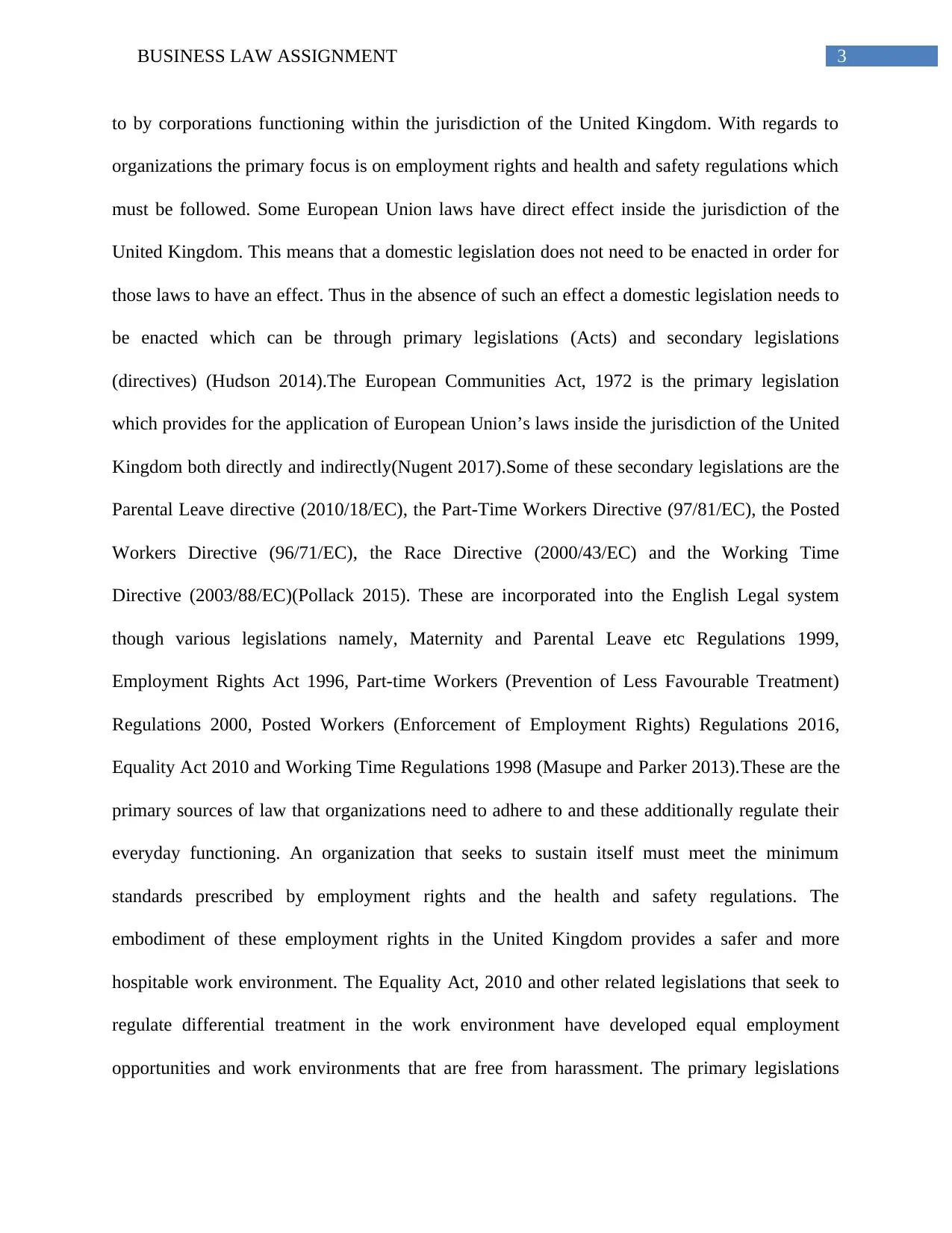
3BUSINESS LAW ASSIGNMENT
to by corporations functioning within the jurisdiction of the United Kingdom. With regards to
organizations the primary focus is on employment rights and health and safety regulations which
must be followed. Some European Union laws have direct effect inside the jurisdiction of the
United Kingdom. This means that a domestic legislation does not need to be enacted in order for
those laws to have an effect. Thus in the absence of such an effect a domestic legislation needs to
be enacted which can be through primary legislations (Acts) and secondary legislations
(directives) (Hudson 2014).The European Communities Act, 1972 is the primary legislation
which provides for the application of European Union’s laws inside the jurisdiction of the United
Kingdom both directly and indirectly(Nugent 2017).Some of these secondary legislations are the
Parental Leave directive (2010/18/EC), the Part-Time Workers Directive (97/81/EC), the Posted
Workers Directive (96/71/EC), the Race Directive (2000/43/EC) and the Working Time
Directive (2003/88/EC)(Pollack 2015). These are incorporated into the English Legal system
though various legislations namely, Maternity and Parental Leave etc Regulations 1999,
Employment Rights Act 1996, Part-time Workers (Prevention of Less Favourable Treatment)
Regulations 2000, Posted Workers (Enforcement of Employment Rights) Regulations 2016,
Equality Act 2010 and Working Time Regulations 1998 (Masupe and Parker 2013).These are the
primary sources of law that organizations need to adhere to and these additionally regulate their
everyday functioning. An organization that seeks to sustain itself must meet the minimum
standards prescribed by employment rights and the health and safety regulations. The
embodiment of these employment rights in the United Kingdom provides a safer and more
hospitable work environment. The Equality Act, 2010 and other related legislations that seek to
regulate differential treatment in the work environment have developed equal employment
opportunities and work environments that are free from harassment. The primary legislations
to by corporations functioning within the jurisdiction of the United Kingdom. With regards to
organizations the primary focus is on employment rights and health and safety regulations which
must be followed. Some European Union laws have direct effect inside the jurisdiction of the
United Kingdom. This means that a domestic legislation does not need to be enacted in order for
those laws to have an effect. Thus in the absence of such an effect a domestic legislation needs to
be enacted which can be through primary legislations (Acts) and secondary legislations
(directives) (Hudson 2014).The European Communities Act, 1972 is the primary legislation
which provides for the application of European Union’s laws inside the jurisdiction of the United
Kingdom both directly and indirectly(Nugent 2017).Some of these secondary legislations are the
Parental Leave directive (2010/18/EC), the Part-Time Workers Directive (97/81/EC), the Posted
Workers Directive (96/71/EC), the Race Directive (2000/43/EC) and the Working Time
Directive (2003/88/EC)(Pollack 2015). These are incorporated into the English Legal system
though various legislations namely, Maternity and Parental Leave etc Regulations 1999,
Employment Rights Act 1996, Part-time Workers (Prevention of Less Favourable Treatment)
Regulations 2000, Posted Workers (Enforcement of Employment Rights) Regulations 2016,
Equality Act 2010 and Working Time Regulations 1998 (Masupe and Parker 2013).These are the
primary sources of law that organizations need to adhere to and these additionally regulate their
everyday functioning. An organization that seeks to sustain itself must meet the minimum
standards prescribed by employment rights and the health and safety regulations. The
embodiment of these employment rights in the United Kingdom provides a safer and more
hospitable work environment. The Equality Act, 2010 and other related legislations that seek to
regulate differential treatment in the work environment have developed equal employment
opportunities and work environments that are free from harassment. The primary legislations
Paraphrase This Document
Need a fresh take? Get an instant paraphrase of this document with our AI Paraphraser
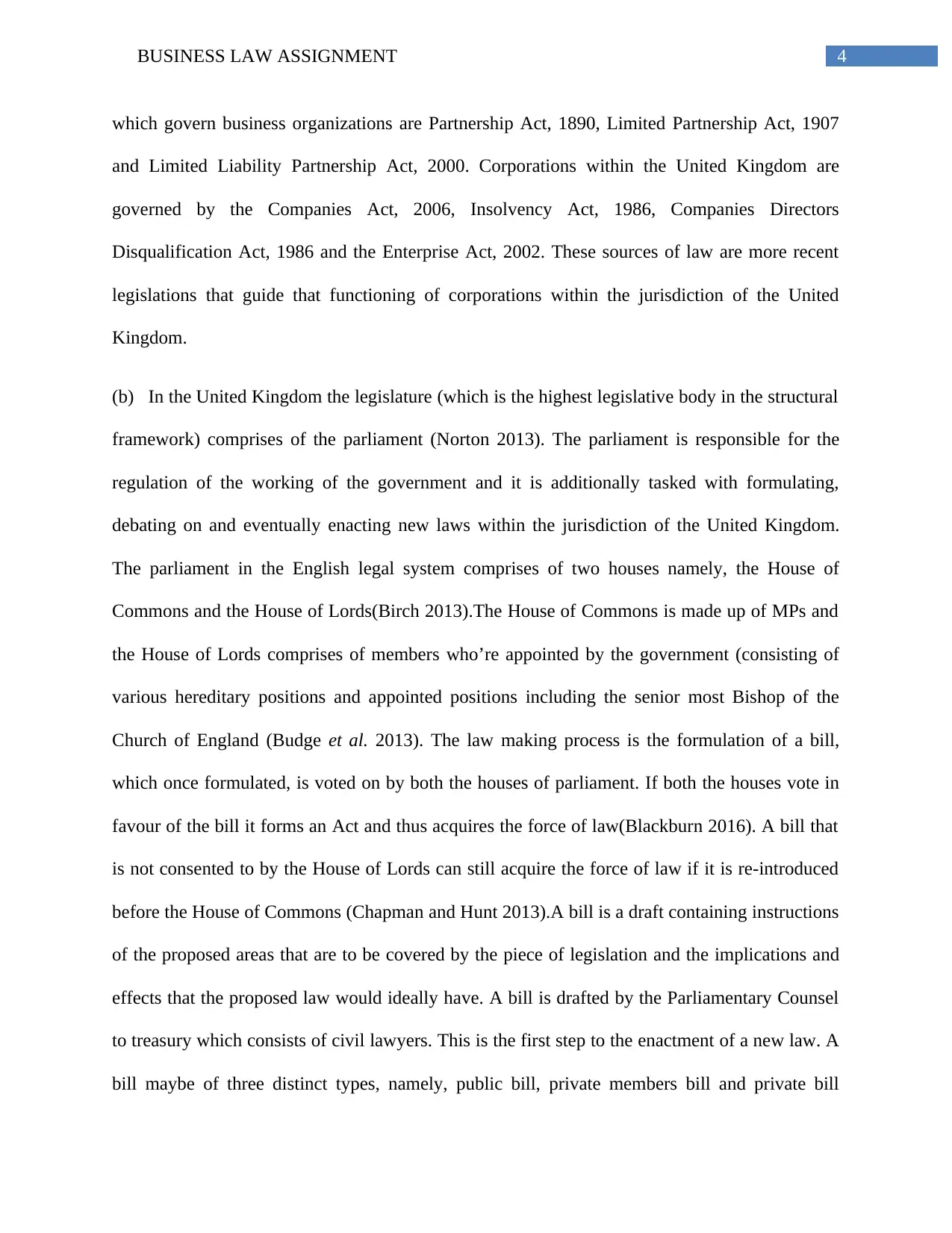
4BUSINESS LAW ASSIGNMENT
which govern business organizations are Partnership Act, 1890, Limited Partnership Act, 1907
and Limited Liability Partnership Act, 2000. Corporations within the United Kingdom are
governed by the Companies Act, 2006, Insolvency Act, 1986, Companies Directors
Disqualification Act, 1986 and the Enterprise Act, 2002. These sources of law are more recent
legislations that guide that functioning of corporations within the jurisdiction of the United
Kingdom.
(b) In the United Kingdom the legislature (which is the highest legislative body in the structural
framework) comprises of the parliament (Norton 2013). The parliament is responsible for the
regulation of the working of the government and it is additionally tasked with formulating,
debating on and eventually enacting new laws within the jurisdiction of the United Kingdom.
The parliament in the English legal system comprises of two houses namely, the House of
Commons and the House of Lords(Birch 2013).The House of Commons is made up of MPs and
the House of Lords comprises of members who’re appointed by the government (consisting of
various hereditary positions and appointed positions including the senior most Bishop of the
Church of England (Budge et al. 2013). The law making process is the formulation of a bill,
which once formulated, is voted on by both the houses of parliament. If both the houses vote in
favour of the bill it forms an Act and thus acquires the force of law(Blackburn 2016). A bill that
is not consented to by the House of Lords can still acquire the force of law if it is re-introduced
before the House of Commons (Chapman and Hunt 2013).A bill is a draft containing instructions
of the proposed areas that are to be covered by the piece of legislation and the implications and
effects that the proposed law would ideally have. A bill is drafted by the Parliamentary Counsel
to treasury which consists of civil lawyers. This is the first step to the enactment of a new law. A
bill maybe of three distinct types, namely, public bill, private members bill and private bill
which govern business organizations are Partnership Act, 1890, Limited Partnership Act, 1907
and Limited Liability Partnership Act, 2000. Corporations within the United Kingdom are
governed by the Companies Act, 2006, Insolvency Act, 1986, Companies Directors
Disqualification Act, 1986 and the Enterprise Act, 2002. These sources of law are more recent
legislations that guide that functioning of corporations within the jurisdiction of the United
Kingdom.
(b) In the United Kingdom the legislature (which is the highest legislative body in the structural
framework) comprises of the parliament (Norton 2013). The parliament is responsible for the
regulation of the working of the government and it is additionally tasked with formulating,
debating on and eventually enacting new laws within the jurisdiction of the United Kingdom.
The parliament in the English legal system comprises of two houses namely, the House of
Commons and the House of Lords(Birch 2013).The House of Commons is made up of MPs and
the House of Lords comprises of members who’re appointed by the government (consisting of
various hereditary positions and appointed positions including the senior most Bishop of the
Church of England (Budge et al. 2013). The law making process is the formulation of a bill,
which once formulated, is voted on by both the houses of parliament. If both the houses vote in
favour of the bill it forms an Act and thus acquires the force of law(Blackburn 2016). A bill that
is not consented to by the House of Lords can still acquire the force of law if it is re-introduced
before the House of Commons (Chapman and Hunt 2013).A bill is a draft containing instructions
of the proposed areas that are to be covered by the piece of legislation and the implications and
effects that the proposed law would ideally have. A bill is drafted by the Parliamentary Counsel
to treasury which consists of civil lawyers. This is the first step to the enactment of a new law. A
bill maybe of three distinct types, namely, public bill, private members bill and private bill
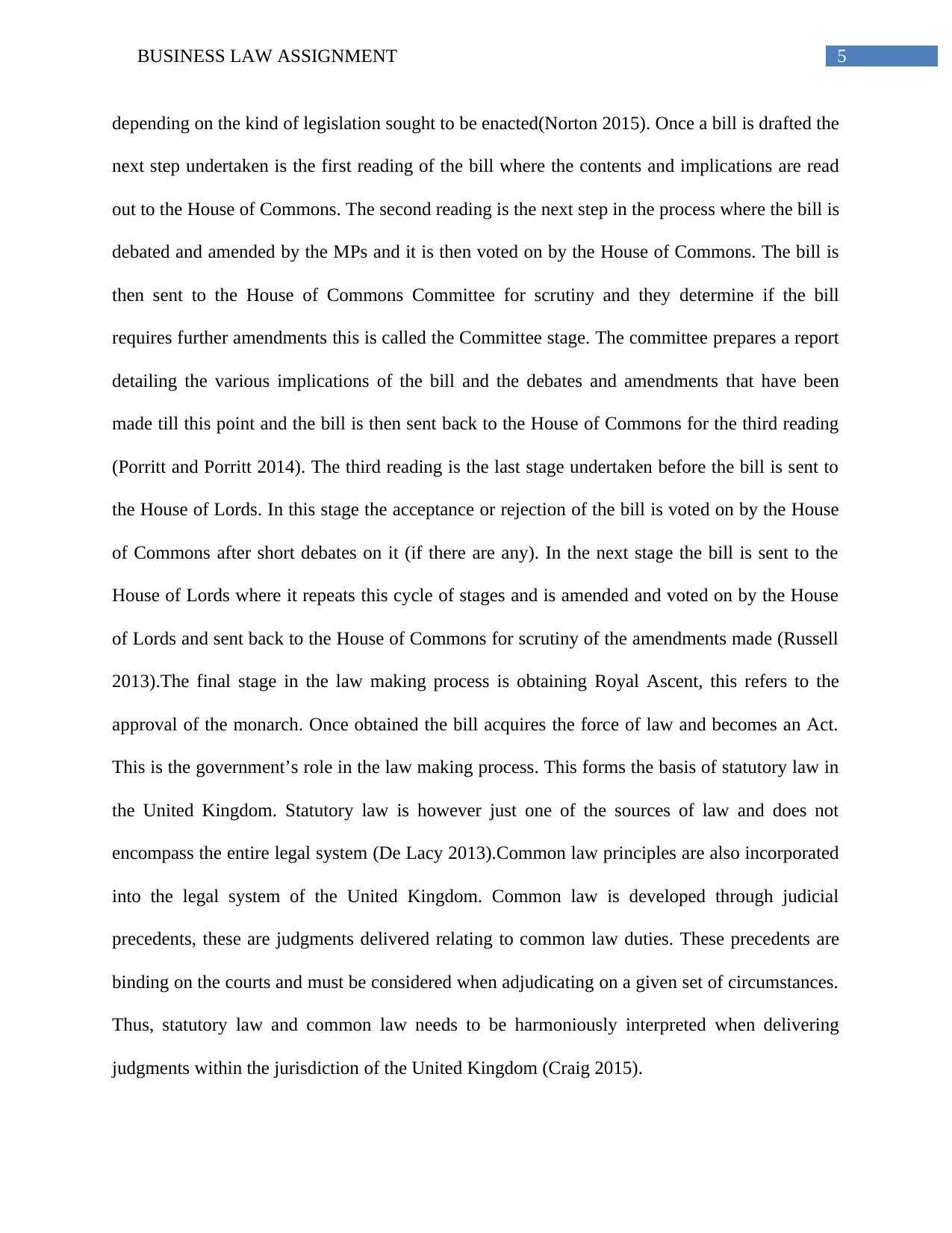
5BUSINESS LAW ASSIGNMENT
depending on the kind of legislation sought to be enacted(Norton 2015). Once a bill is drafted the
next step undertaken is the first reading of the bill where the contents and implications are read
out to the House of Commons. The second reading is the next step in the process where the bill is
debated and amended by the MPs and it is then voted on by the House of Commons. The bill is
then sent to the House of Commons Committee for scrutiny and they determine if the bill
requires further amendments this is called the Committee stage. The committee prepares a report
detailing the various implications of the bill and the debates and amendments that have been
made till this point and the bill is then sent back to the House of Commons for the third reading
(Porritt and Porritt 2014). The third reading is the last stage undertaken before the bill is sent to
the House of Lords. In this stage the acceptance or rejection of the bill is voted on by the House
of Commons after short debates on it (if there are any). In the next stage the bill is sent to the
House of Lords where it repeats this cycle of stages and is amended and voted on by the House
of Lords and sent back to the House of Commons for scrutiny of the amendments made (Russell
2013).The final stage in the law making process is obtaining Royal Ascent, this refers to the
approval of the monarch. Once obtained the bill acquires the force of law and becomes an Act.
This is the government’s role in the law making process. This forms the basis of statutory law in
the United Kingdom. Statutory law is however just one of the sources of law and does not
encompass the entire legal system (De Lacy 2013).Common law principles are also incorporated
into the legal system of the United Kingdom. Common law is developed through judicial
precedents, these are judgments delivered relating to common law duties. These precedents are
binding on the courts and must be considered when adjudicating on a given set of circumstances.
Thus, statutory law and common law needs to be harmoniously interpreted when delivering
judgments within the jurisdiction of the United Kingdom (Craig 2015).
depending on the kind of legislation sought to be enacted(Norton 2015). Once a bill is drafted the
next step undertaken is the first reading of the bill where the contents and implications are read
out to the House of Commons. The second reading is the next step in the process where the bill is
debated and amended by the MPs and it is then voted on by the House of Commons. The bill is
then sent to the House of Commons Committee for scrutiny and they determine if the bill
requires further amendments this is called the Committee stage. The committee prepares a report
detailing the various implications of the bill and the debates and amendments that have been
made till this point and the bill is then sent back to the House of Commons for the third reading
(Porritt and Porritt 2014). The third reading is the last stage undertaken before the bill is sent to
the House of Lords. In this stage the acceptance or rejection of the bill is voted on by the House
of Commons after short debates on it (if there are any). In the next stage the bill is sent to the
House of Lords where it repeats this cycle of stages and is amended and voted on by the House
of Lords and sent back to the House of Commons for scrutiny of the amendments made (Russell
2013).The final stage in the law making process is obtaining Royal Ascent, this refers to the
approval of the monarch. Once obtained the bill acquires the force of law and becomes an Act.
This is the government’s role in the law making process. This forms the basis of statutory law in
the United Kingdom. Statutory law is however just one of the sources of law and does not
encompass the entire legal system (De Lacy 2013).Common law principles are also incorporated
into the legal system of the United Kingdom. Common law is developed through judicial
precedents, these are judgments delivered relating to common law duties. These precedents are
binding on the courts and must be considered when adjudicating on a given set of circumstances.
Thus, statutory law and common law needs to be harmoniously interpreted when delivering
judgments within the jurisdiction of the United Kingdom (Craig 2015).
⊘ This is a preview!⊘
Do you want full access?
Subscribe today to unlock all pages.

Trusted by 1+ million students worldwide
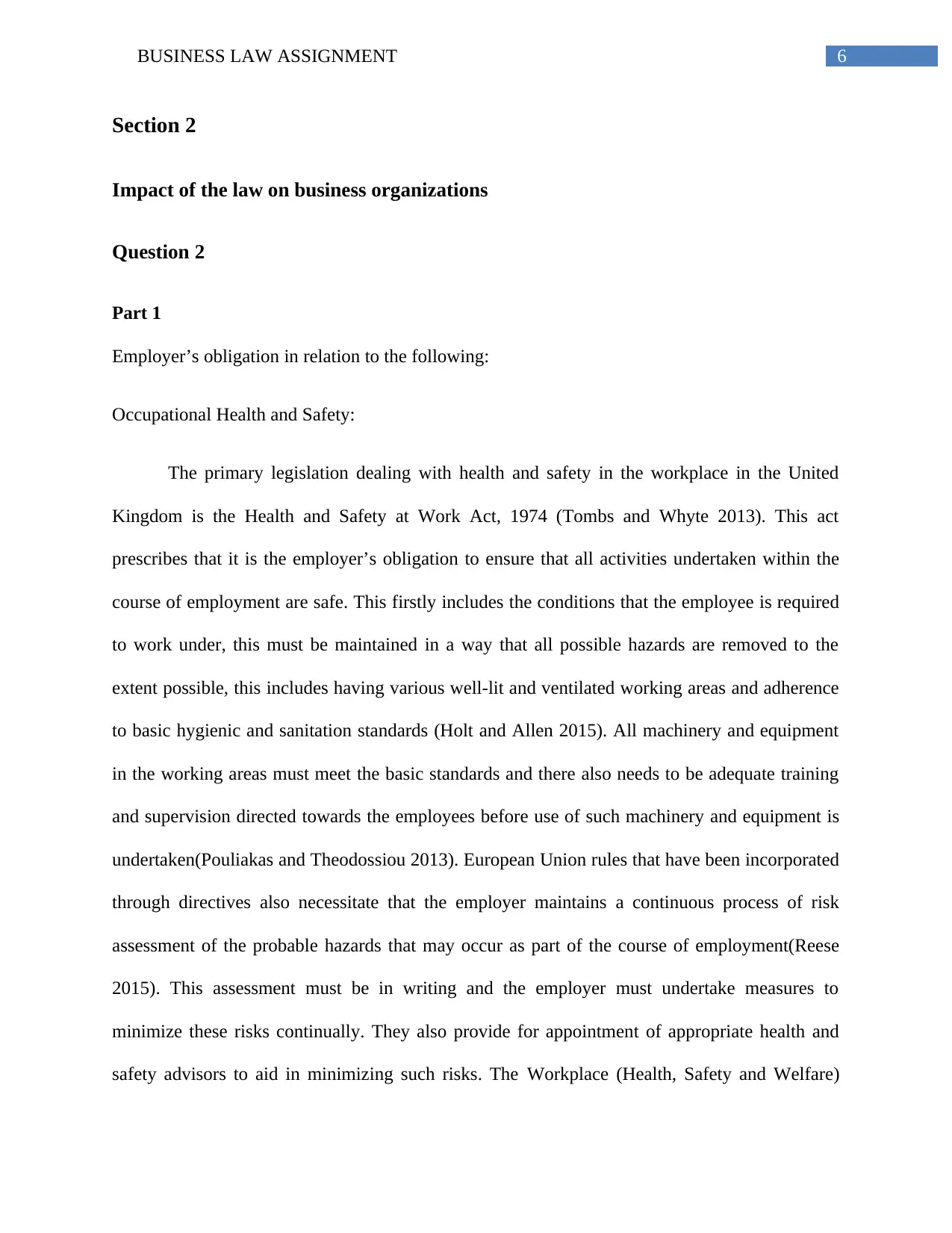
6BUSINESS LAW ASSIGNMENT
Section 2
Impact of the law on business organizations
Question 2
Part 1
Employer’s obligation in relation to the following:
Occupational Health and Safety:
The primary legislation dealing with health and safety in the workplace in the United
Kingdom is the Health and Safety at Work Act, 1974 (Tombs and Whyte 2013). This act
prescribes that it is the employer’s obligation to ensure that all activities undertaken within the
course of employment are safe. This firstly includes the conditions that the employee is required
to work under, this must be maintained in a way that all possible hazards are removed to the
extent possible, this includes having various well-lit and ventilated working areas and adherence
to basic hygienic and sanitation standards (Holt and Allen 2015). All machinery and equipment
in the working areas must meet the basic standards and there also needs to be adequate training
and supervision directed towards the employees before use of such machinery and equipment is
undertaken(Pouliakas and Theodossiou 2013). European Union rules that have been incorporated
through directives also necessitate that the employer maintains a continuous process of risk
assessment of the probable hazards that may occur as part of the course of employment(Reese
2015). This assessment must be in writing and the employer must undertake measures to
minimize these risks continually. They also provide for appointment of appropriate health and
safety advisors to aid in minimizing such risks. The Workplace (Health, Safety and Welfare)
Section 2
Impact of the law on business organizations
Question 2
Part 1
Employer’s obligation in relation to the following:
Occupational Health and Safety:
The primary legislation dealing with health and safety in the workplace in the United
Kingdom is the Health and Safety at Work Act, 1974 (Tombs and Whyte 2013). This act
prescribes that it is the employer’s obligation to ensure that all activities undertaken within the
course of employment are safe. This firstly includes the conditions that the employee is required
to work under, this must be maintained in a way that all possible hazards are removed to the
extent possible, this includes having various well-lit and ventilated working areas and adherence
to basic hygienic and sanitation standards (Holt and Allen 2015). All machinery and equipment
in the working areas must meet the basic standards and there also needs to be adequate training
and supervision directed towards the employees before use of such machinery and equipment is
undertaken(Pouliakas and Theodossiou 2013). European Union rules that have been incorporated
through directives also necessitate that the employer maintains a continuous process of risk
assessment of the probable hazards that may occur as part of the course of employment(Reese
2015). This assessment must be in writing and the employer must undertake measures to
minimize these risks continually. They also provide for appointment of appropriate health and
safety advisors to aid in minimizing such risks. The Workplace (Health, Safety and Welfare)
Paraphrase This Document
Need a fresh take? Get an instant paraphrase of this document with our AI Paraphraser
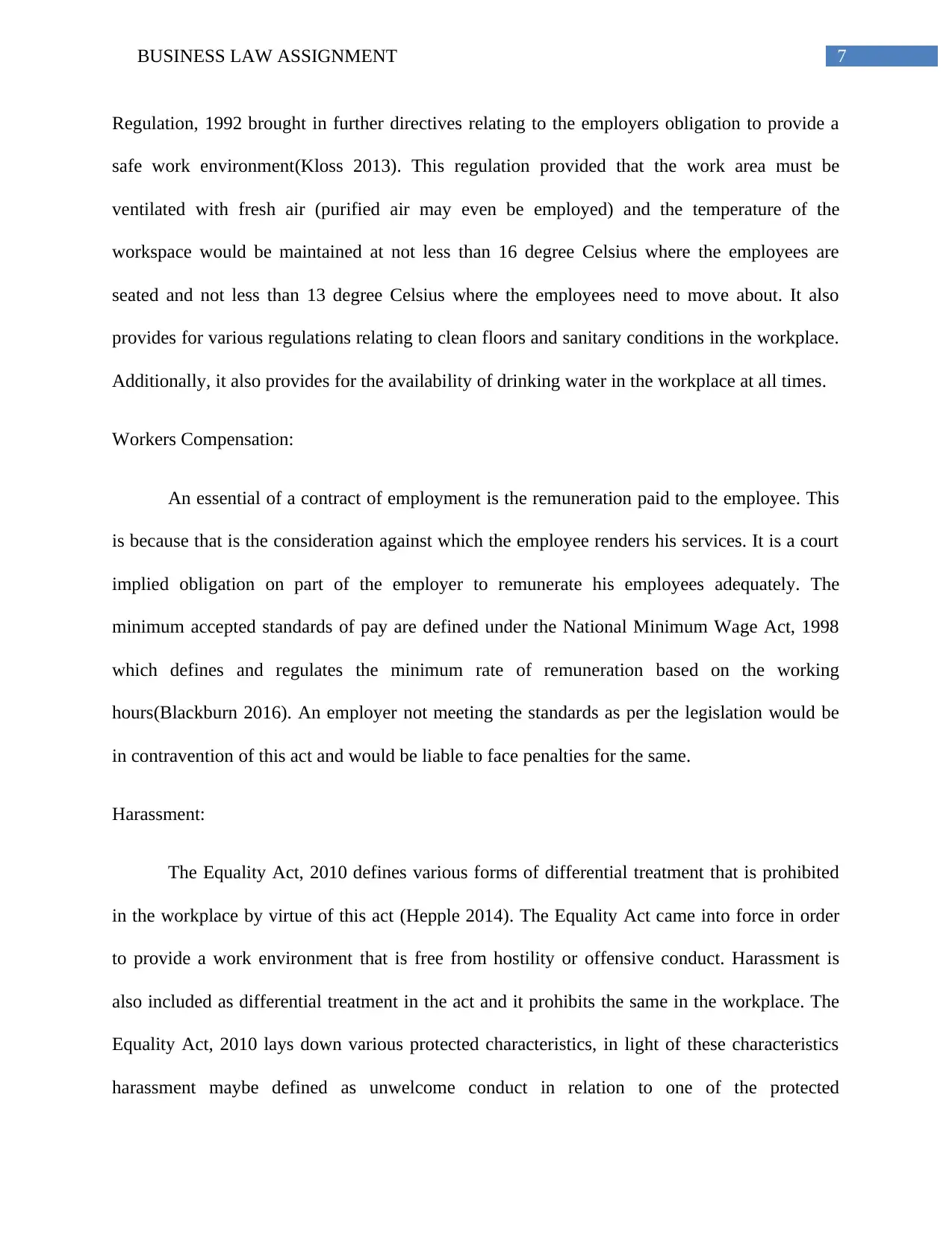
7BUSINESS LAW ASSIGNMENT
Regulation, 1992 brought in further directives relating to the employers obligation to provide a
safe work environment(Kloss 2013). This regulation provided that the work area must be
ventilated with fresh air (purified air may even be employed) and the temperature of the
workspace would be maintained at not less than 16 degree Celsius where the employees are
seated and not less than 13 degree Celsius where the employees need to move about. It also
provides for various regulations relating to clean floors and sanitary conditions in the workplace.
Additionally, it also provides for the availability of drinking water in the workplace at all times.
Workers Compensation:
An essential of a contract of employment is the remuneration paid to the employee. This
is because that is the consideration against which the employee renders his services. It is a court
implied obligation on part of the employer to remunerate his employees adequately. The
minimum accepted standards of pay are defined under the National Minimum Wage Act, 1998
which defines and regulates the minimum rate of remuneration based on the working
hours(Blackburn 2016). An employer not meeting the standards as per the legislation would be
in contravention of this act and would be liable to face penalties for the same.
Harassment:
The Equality Act, 2010 defines various forms of differential treatment that is prohibited
in the workplace by virtue of this act (Hepple 2014). The Equality Act came into force in order
to provide a work environment that is free from hostility or offensive conduct. Harassment is
also included as differential treatment in the act and it prohibits the same in the workplace. The
Equality Act, 2010 lays down various protected characteristics, in light of these characteristics
harassment maybe defined as unwelcome conduct in relation to one of the protected
Regulation, 1992 brought in further directives relating to the employers obligation to provide a
safe work environment(Kloss 2013). This regulation provided that the work area must be
ventilated with fresh air (purified air may even be employed) and the temperature of the
workspace would be maintained at not less than 16 degree Celsius where the employees are
seated and not less than 13 degree Celsius where the employees need to move about. It also
provides for various regulations relating to clean floors and sanitary conditions in the workplace.
Additionally, it also provides for the availability of drinking water in the workplace at all times.
Workers Compensation:
An essential of a contract of employment is the remuneration paid to the employee. This
is because that is the consideration against which the employee renders his services. It is a court
implied obligation on part of the employer to remunerate his employees adequately. The
minimum accepted standards of pay are defined under the National Minimum Wage Act, 1998
which defines and regulates the minimum rate of remuneration based on the working
hours(Blackburn 2016). An employer not meeting the standards as per the legislation would be
in contravention of this act and would be liable to face penalties for the same.
Harassment:
The Equality Act, 2010 defines various forms of differential treatment that is prohibited
in the workplace by virtue of this act (Hepple 2014). The Equality Act came into force in order
to provide a work environment that is free from hostility or offensive conduct. Harassment is
also included as differential treatment in the act and it prohibits the same in the workplace. The
Equality Act, 2010 lays down various protected characteristics, in light of these characteristics
harassment maybe defined as unwelcome conduct in relation to one of the protected
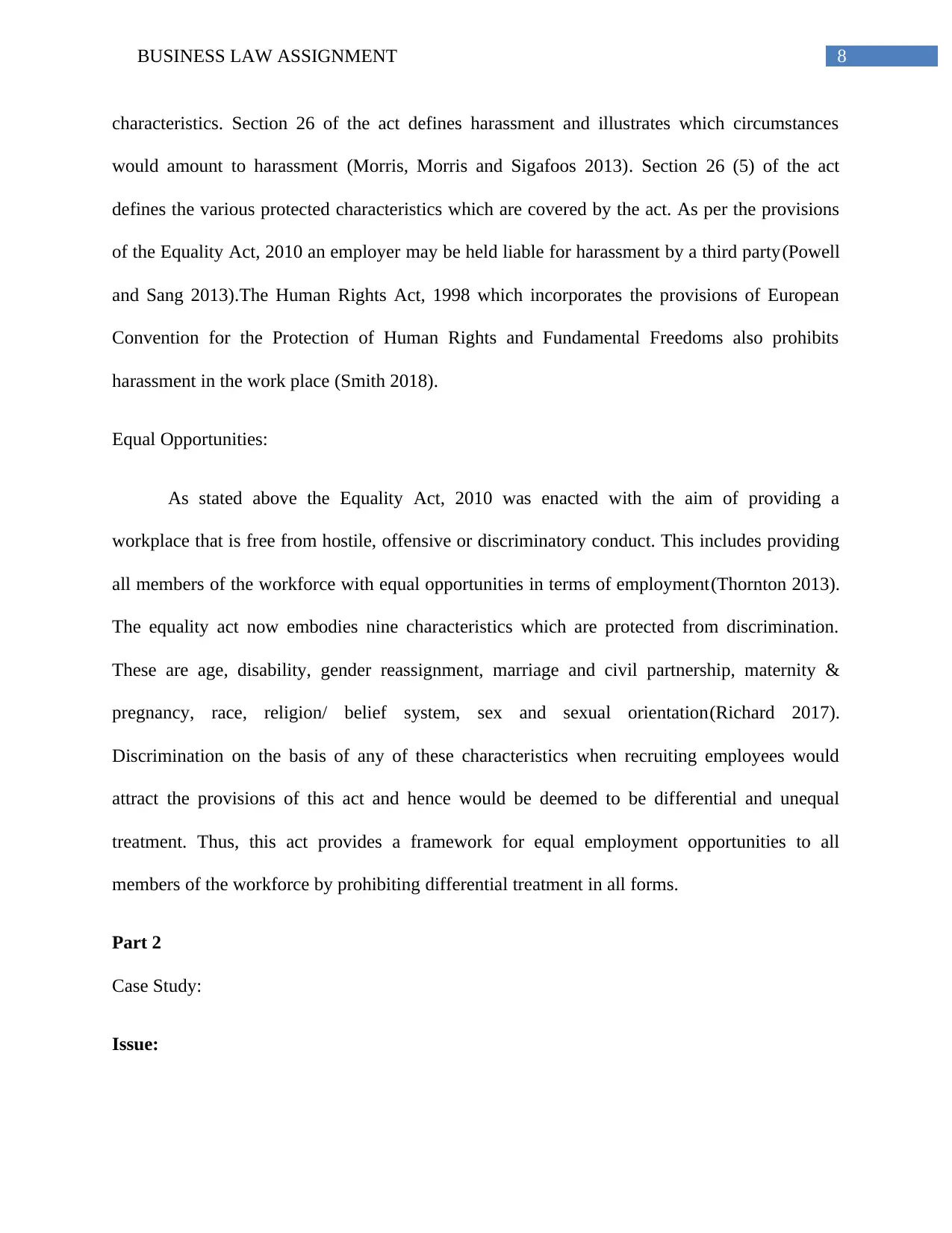
8BUSINESS LAW ASSIGNMENT
characteristics. Section 26 of the act defines harassment and illustrates which circumstances
would amount to harassment (Morris, Morris and Sigafoos 2013). Section 26 (5) of the act
defines the various protected characteristics which are covered by the act. As per the provisions
of the Equality Act, 2010 an employer may be held liable for harassment by a third party(Powell
and Sang 2013).The Human Rights Act, 1998 which incorporates the provisions of European
Convention for the Protection of Human Rights and Fundamental Freedoms also prohibits
harassment in the work place (Smith 2018).
Equal Opportunities:
As stated above the Equality Act, 2010 was enacted with the aim of providing a
workplace that is free from hostile, offensive or discriminatory conduct. This includes providing
all members of the workforce with equal opportunities in terms of employment(Thornton 2013).
The equality act now embodies nine characteristics which are protected from discrimination.
These are age, disability, gender reassignment, marriage and civil partnership, maternity &
pregnancy, race, religion/ belief system, sex and sexual orientation(Richard 2017).
Discrimination on the basis of any of these characteristics when recruiting employees would
attract the provisions of this act and hence would be deemed to be differential and unequal
treatment. Thus, this act provides a framework for equal employment opportunities to all
members of the workforce by prohibiting differential treatment in all forms.
Part 2
Case Study:
Issue:
characteristics. Section 26 of the act defines harassment and illustrates which circumstances
would amount to harassment (Morris, Morris and Sigafoos 2013). Section 26 (5) of the act
defines the various protected characteristics which are covered by the act. As per the provisions
of the Equality Act, 2010 an employer may be held liable for harassment by a third party(Powell
and Sang 2013).The Human Rights Act, 1998 which incorporates the provisions of European
Convention for the Protection of Human Rights and Fundamental Freedoms also prohibits
harassment in the work place (Smith 2018).
Equal Opportunities:
As stated above the Equality Act, 2010 was enacted with the aim of providing a
workplace that is free from hostile, offensive or discriminatory conduct. This includes providing
all members of the workforce with equal opportunities in terms of employment(Thornton 2013).
The equality act now embodies nine characteristics which are protected from discrimination.
These are age, disability, gender reassignment, marriage and civil partnership, maternity &
pregnancy, race, religion/ belief system, sex and sexual orientation(Richard 2017).
Discrimination on the basis of any of these characteristics when recruiting employees would
attract the provisions of this act and hence would be deemed to be differential and unequal
treatment. Thus, this act provides a framework for equal employment opportunities to all
members of the workforce by prohibiting differential treatment in all forms.
Part 2
Case Study:
Issue:
⊘ This is a preview!⊘
Do you want full access?
Subscribe today to unlock all pages.

Trusted by 1+ million students worldwide
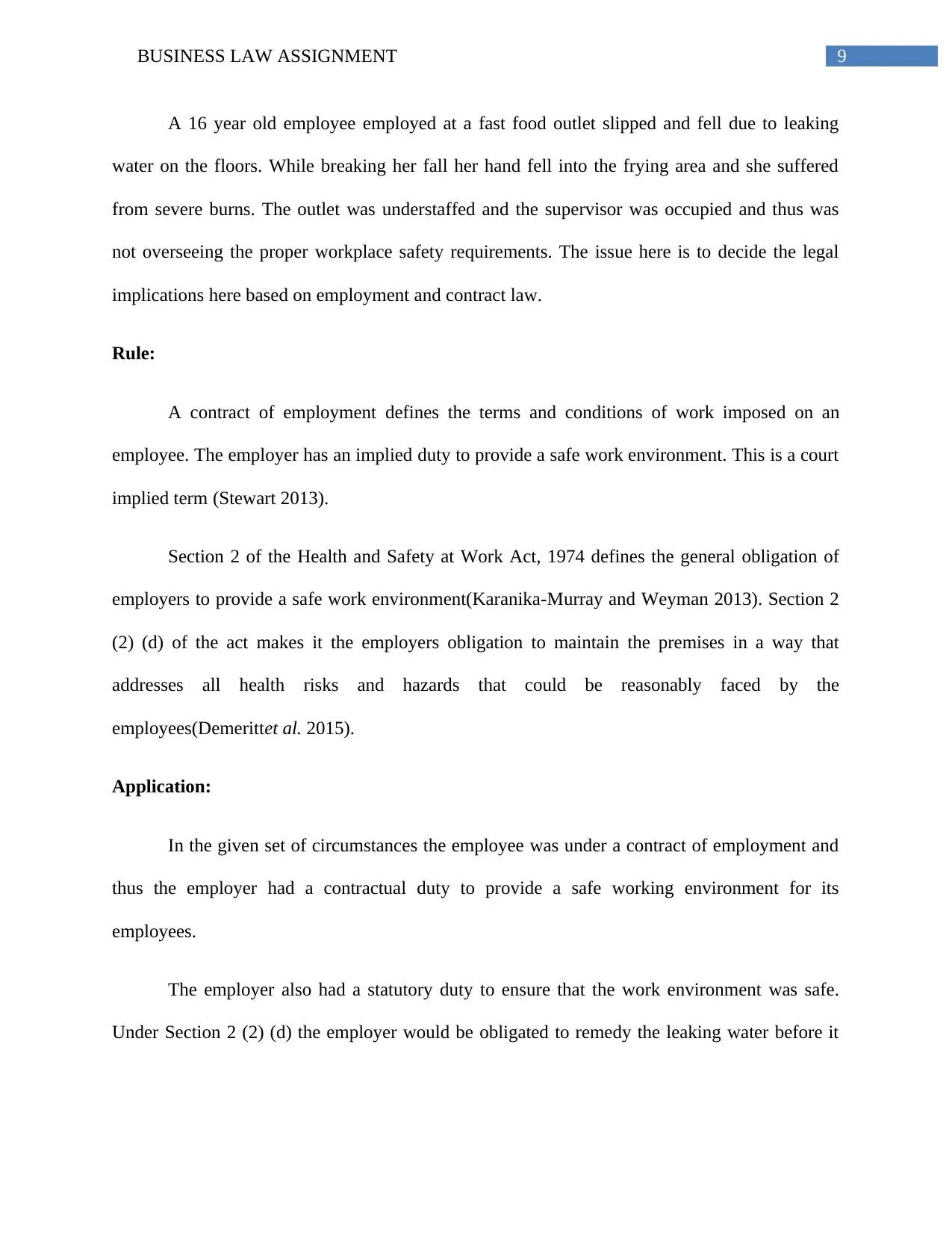
9BUSINESS LAW ASSIGNMENT
A 16 year old employee employed at a fast food outlet slipped and fell due to leaking
water on the floors. While breaking her fall her hand fell into the frying area and she suffered
from severe burns. The outlet was understaffed and the supervisor was occupied and thus was
not overseeing the proper workplace safety requirements. The issue here is to decide the legal
implications here based on employment and contract law.
Rule:
A contract of employment defines the terms and conditions of work imposed on an
employee. The employer has an implied duty to provide a safe work environment. This is a court
implied term (Stewart 2013).
Section 2 of the Health and Safety at Work Act, 1974 defines the general obligation of
employers to provide a safe work environment(Karanika-Murray and Weyman 2013). Section 2
(2) (d) of the act makes it the employers obligation to maintain the premises in a way that
addresses all health risks and hazards that could be reasonably faced by the
employees(Demerittet al. 2015).
Application:
In the given set of circumstances the employee was under a contract of employment and
thus the employer had a contractual duty to provide a safe working environment for its
employees.
The employer also had a statutory duty to ensure that the work environment was safe.
Under Section 2 (2) (d) the employer would be obligated to remedy the leaking water before it
A 16 year old employee employed at a fast food outlet slipped and fell due to leaking
water on the floors. While breaking her fall her hand fell into the frying area and she suffered
from severe burns. The outlet was understaffed and the supervisor was occupied and thus was
not overseeing the proper workplace safety requirements. The issue here is to decide the legal
implications here based on employment and contract law.
Rule:
A contract of employment defines the terms and conditions of work imposed on an
employee. The employer has an implied duty to provide a safe work environment. This is a court
implied term (Stewart 2013).
Section 2 of the Health and Safety at Work Act, 1974 defines the general obligation of
employers to provide a safe work environment(Karanika-Murray and Weyman 2013). Section 2
(2) (d) of the act makes it the employers obligation to maintain the premises in a way that
addresses all health risks and hazards that could be reasonably faced by the
employees(Demerittet al. 2015).
Application:
In the given set of circumstances the employee was under a contract of employment and
thus the employer had a contractual duty to provide a safe working environment for its
employees.
The employer also had a statutory duty to ensure that the work environment was safe.
Under Section 2 (2) (d) the employer would be obligated to remedy the leaking water before it
Paraphrase This Document
Need a fresh take? Get an instant paraphrase of this document with our AI Paraphraser
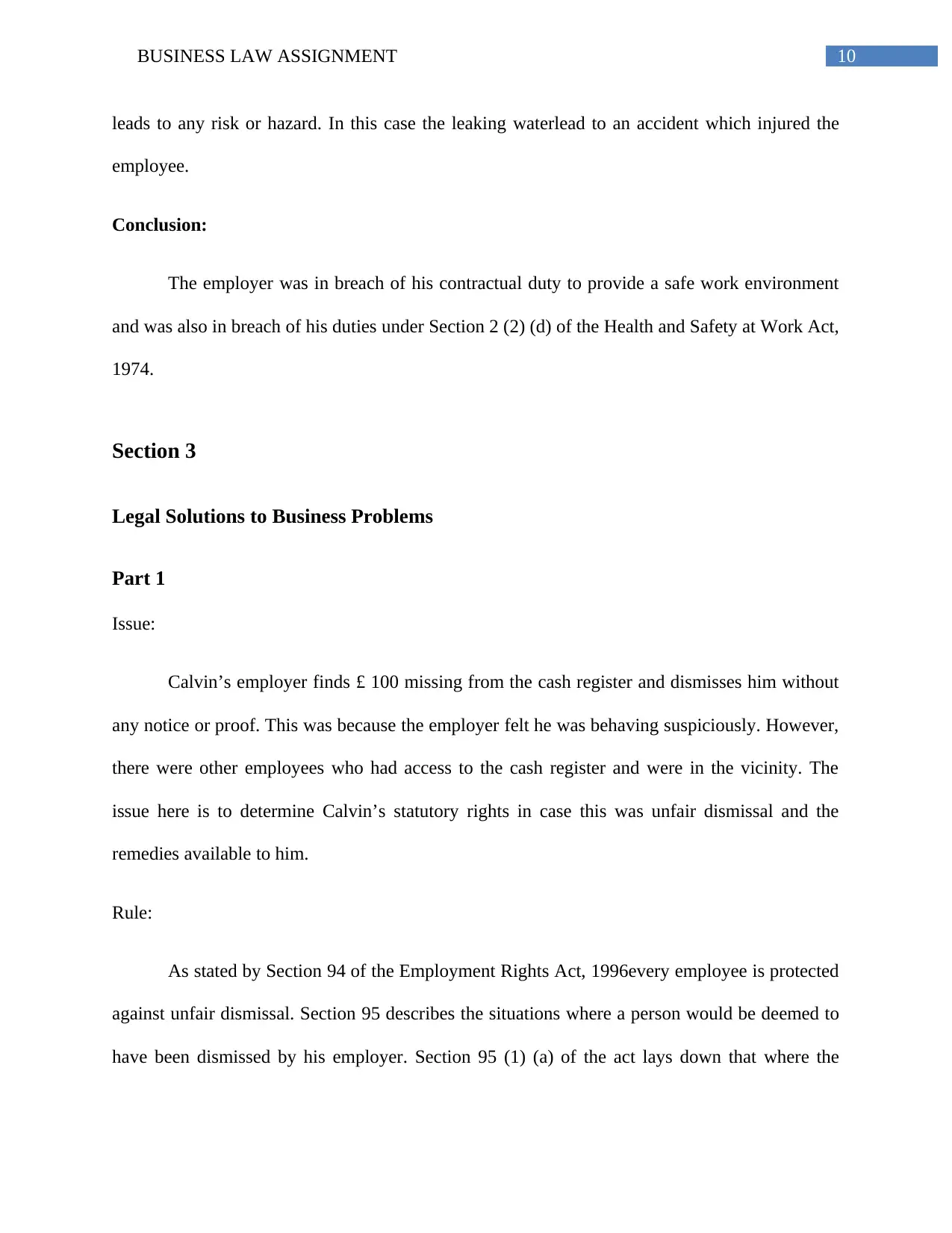
10BUSINESS LAW ASSIGNMENT
leads to any risk or hazard. In this case the leaking waterlead to an accident which injured the
employee.
Conclusion:
The employer was in breach of his contractual duty to provide a safe work environment
and was also in breach of his duties under Section 2 (2) (d) of the Health and Safety at Work Act,
1974.
Section 3
Legal Solutions to Business Problems
Part 1
Issue:
Calvin’s employer finds £ 100 missing from the cash register and dismisses him without
any notice or proof. This was because the employer felt he was behaving suspiciously. However,
there were other employees who had access to the cash register and were in the vicinity. The
issue here is to determine Calvin’s statutory rights in case this was unfair dismissal and the
remedies available to him.
Rule:
As stated by Section 94 of the Employment Rights Act, 1996every employee is protected
against unfair dismissal. Section 95 describes the situations where a person would be deemed to
have been dismissed by his employer. Section 95 (1) (a) of the act lays down that where the
leads to any risk or hazard. In this case the leaking waterlead to an accident which injured the
employee.
Conclusion:
The employer was in breach of his contractual duty to provide a safe work environment
and was also in breach of his duties under Section 2 (2) (d) of the Health and Safety at Work Act,
1974.
Section 3
Legal Solutions to Business Problems
Part 1
Issue:
Calvin’s employer finds £ 100 missing from the cash register and dismisses him without
any notice or proof. This was because the employer felt he was behaving suspiciously. However,
there were other employees who had access to the cash register and were in the vicinity. The
issue here is to determine Calvin’s statutory rights in case this was unfair dismissal and the
remedies available to him.
Rule:
As stated by Section 94 of the Employment Rights Act, 1996every employee is protected
against unfair dismissal. Section 95 describes the situations where a person would be deemed to
have been dismissed by his employer. Section 95 (1) (a) of the act lays down that where the
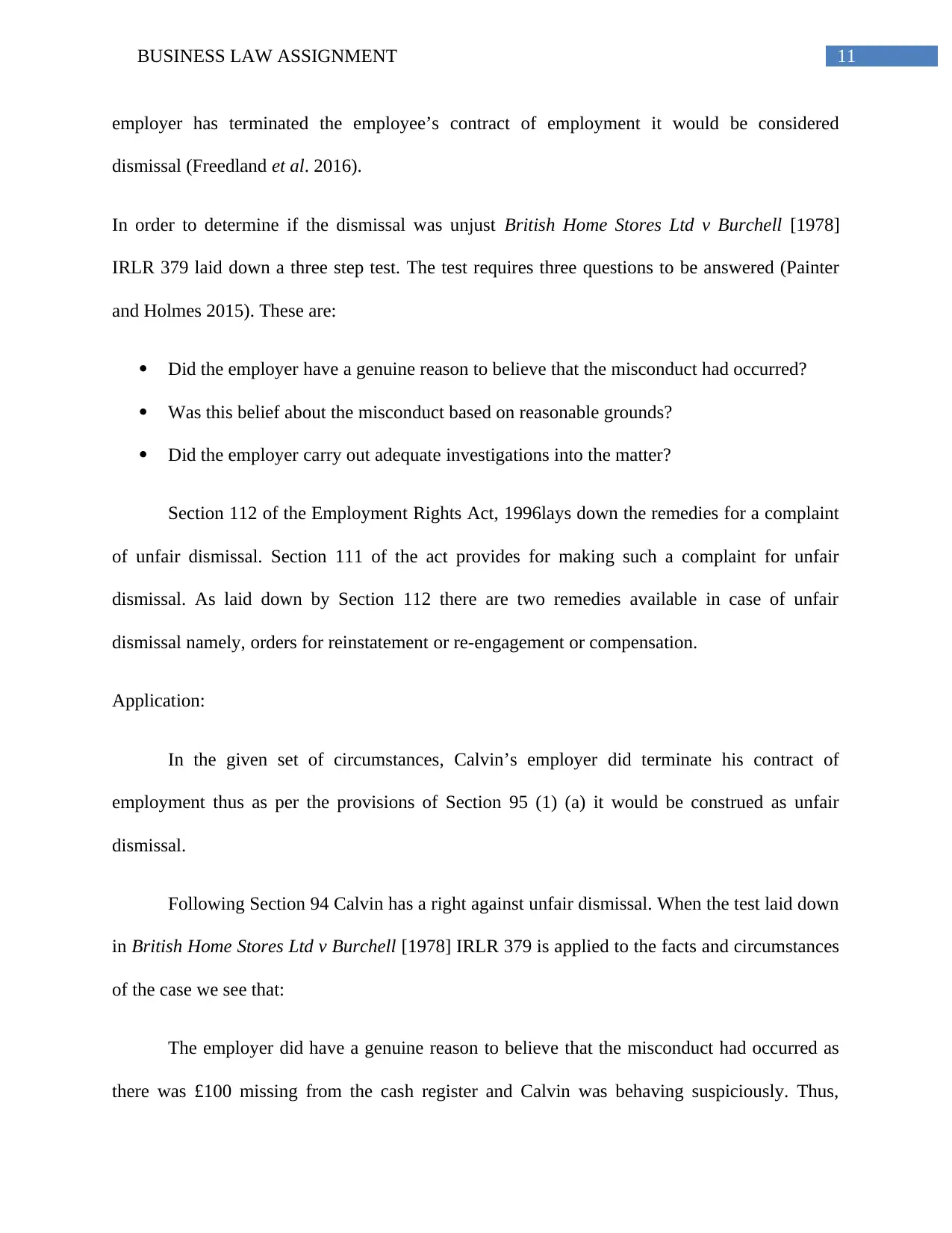
11BUSINESS LAW ASSIGNMENT
employer has terminated the employee’s contract of employment it would be considered
dismissal (Freedland et al. 2016).
In order to determine if the dismissal was unjust British Home Stores Ltd v Burchell [1978]
IRLR 379 laid down a three step test. The test requires three questions to be answered (Painter
and Holmes 2015). These are:
Did the employer have a genuine reason to believe that the misconduct had occurred?
Was this belief about the misconduct based on reasonable grounds?
Did the employer carry out adequate investigations into the matter?
Section 112 of the Employment Rights Act, 1996lays down the remedies for a complaint
of unfair dismissal. Section 111 of the act provides for making such a complaint for unfair
dismissal. As laid down by Section 112 there are two remedies available in case of unfair
dismissal namely, orders for reinstatement or re-engagement or compensation.
Application:
In the given set of circumstances, Calvin’s employer did terminate his contract of
employment thus as per the provisions of Section 95 (1) (a) it would be construed as unfair
dismissal.
Following Section 94 Calvin has a right against unfair dismissal. When the test laid down
in British Home Stores Ltd v Burchell [1978] IRLR 379 is applied to the facts and circumstances
of the case we see that:
The employer did have a genuine reason to believe that the misconduct had occurred as
there was £100 missing from the cash register and Calvin was behaving suspiciously. Thus,
employer has terminated the employee’s contract of employment it would be considered
dismissal (Freedland et al. 2016).
In order to determine if the dismissal was unjust British Home Stores Ltd v Burchell [1978]
IRLR 379 laid down a three step test. The test requires three questions to be answered (Painter
and Holmes 2015). These are:
Did the employer have a genuine reason to believe that the misconduct had occurred?
Was this belief about the misconduct based on reasonable grounds?
Did the employer carry out adequate investigations into the matter?
Section 112 of the Employment Rights Act, 1996lays down the remedies for a complaint
of unfair dismissal. Section 111 of the act provides for making such a complaint for unfair
dismissal. As laid down by Section 112 there are two remedies available in case of unfair
dismissal namely, orders for reinstatement or re-engagement or compensation.
Application:
In the given set of circumstances, Calvin’s employer did terminate his contract of
employment thus as per the provisions of Section 95 (1) (a) it would be construed as unfair
dismissal.
Following Section 94 Calvin has a right against unfair dismissal. When the test laid down
in British Home Stores Ltd v Burchell [1978] IRLR 379 is applied to the facts and circumstances
of the case we see that:
The employer did have a genuine reason to believe that the misconduct had occurred as
there was £100 missing from the cash register and Calvin was behaving suspiciously. Thus,
⊘ This is a preview!⊘
Do you want full access?
Subscribe today to unlock all pages.

Trusted by 1+ million students worldwide
1 out of 22
Related Documents
Your All-in-One AI-Powered Toolkit for Academic Success.
+13062052269
info@desklib.com
Available 24*7 on WhatsApp / Email
![[object Object]](/_next/static/media/star-bottom.7253800d.svg)
Unlock your academic potential
Copyright © 2020–2025 A2Z Services. All Rights Reserved. Developed and managed by ZUCOL.




